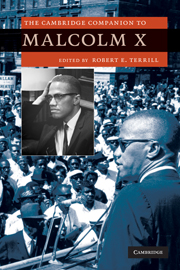Book contents
- Frontmatter
- Introduction
- 1 Malcolm X and Elijah Muhammad
- 2 Autobiography and identity: Malcolm X as author and hero
- 3 Bringing Malcolm X to Hollywood
- 4 Malcolm X and black masculinity in process
- 5 Womanizing Malcolm X
- 6 Malcolm X and the Black Arts Movement
- 7 Malcolm X and African American conservatism
- 8 Malcolm X and youth culture
- 9 Homo rhetoricus Afro-Americanus: Malcolm X and the “rhetorical ideal of life”
- 10 Judgment and critique in the rhetoric of Malcolm X
- 11 Nightmarish landscapes: geography and the dystopian writings of Malcolm X
- 12 Afrocentricity and Malcolm X
- 13 Malcolm X in global perspective
- 14 The legacy of Malcolm X
- Guide to further reading
- Index
13 - Malcolm X in global perspective
Published online by Cambridge University Press: 28 May 2010
- Frontmatter
- Introduction
- 1 Malcolm X and Elijah Muhammad
- 2 Autobiography and identity: Malcolm X as author and hero
- 3 Bringing Malcolm X to Hollywood
- 4 Malcolm X and black masculinity in process
- 5 Womanizing Malcolm X
- 6 Malcolm X and the Black Arts Movement
- 7 Malcolm X and African American conservatism
- 8 Malcolm X and youth culture
- 9 Homo rhetoricus Afro-Americanus: Malcolm X and the “rhetorical ideal of life”
- 10 Judgment and critique in the rhetoric of Malcolm X
- 11 Nightmarish landscapes: geography and the dystopian writings of Malcolm X
- 12 Afrocentricity and Malcolm X
- 13 Malcolm X in global perspective
- 14 The legacy of Malcolm X
- Guide to further reading
- Index
Summary
In August 2008, S. Shankar wrote in the Hindu newspaper, “Now the world is full of Barack Obama, but 50 years ago another young, charismatic Black American filled the world in his own way.” That precursor was Malcolm X, who had filled the world with his indictment of US racism and empire. Shankar invoked his memory to argue that the rise of Obama did not signal, as some would have it, the arrival of a “post-racial” American society. Obama had just captured the nomination of the Democratic party (months before his election as the first African American president in US history). To Shankar, the federal government's shocking negligence in the face of the massive suffering wrought by Hurricane Katrina in 2005 revealed the persistence of racism in American social and political life. “In celebrating Obama, there is no need to forget either Malcolm or Katrina,” Shankar concluded. That Obama transcends race is an article of faith among his supporters; his approach could not be further in temperament from Malcolm's confrontational stance on racism. To be sure, when Malcolm was alive, Southern white extremists could brutalize blacks with impunity. Still, Shankar's comparison reminds us that Obama is a product of the history of the black freedom movement in the United States. That history belongs to the world, due in no small part to Malcolm X's travels to Europe, Africa, and the Middle East, and the importance of his Islamic faith to his rejection of the Nation of Islam's antiwhite doctrine. The African American struggle for equality, which for some, like Shankar, was embodied by Malcolm, inspired people all over the world, throughout Africa, Asia, the Middle East, and Eastern Europe.
- Type
- Chapter
- Information
- The Cambridge Companion to Malcolm X , pp. 158 - 170Publisher: Cambridge University PressPrint publication year: 2010
- 1
- Cited by



